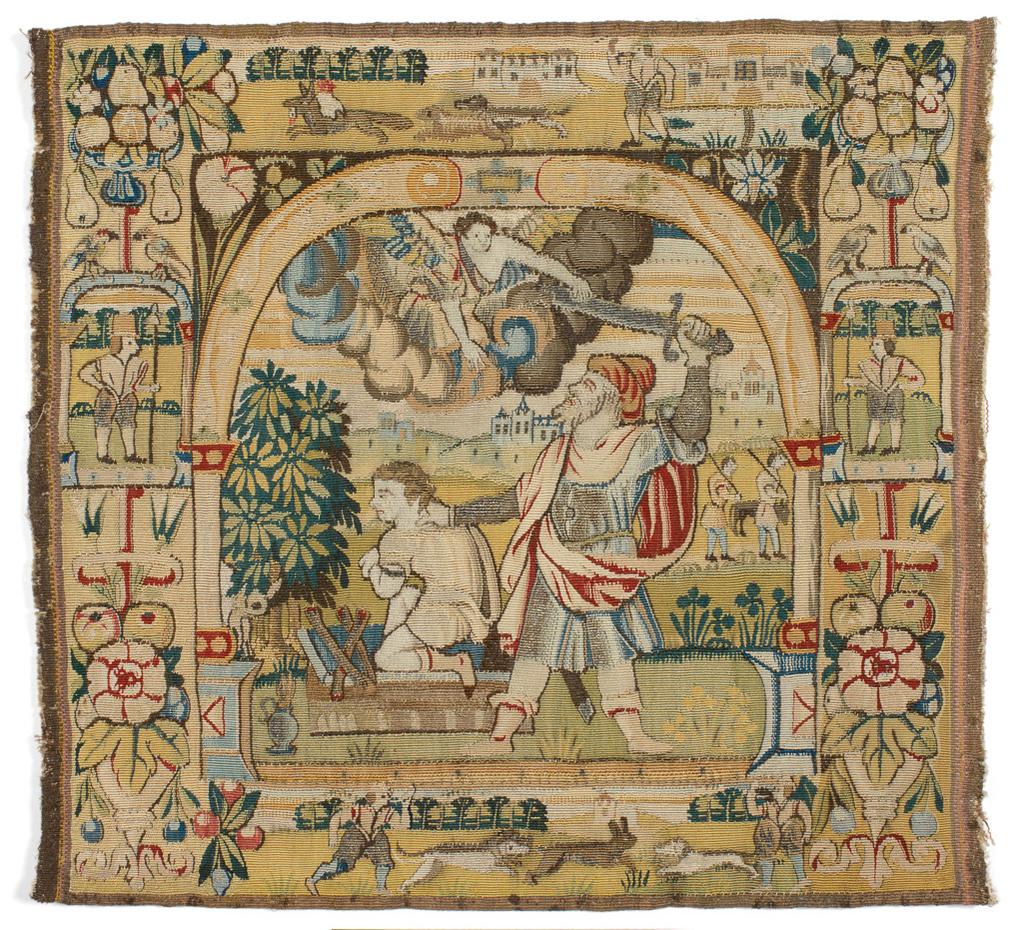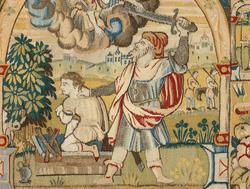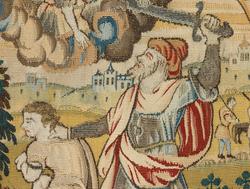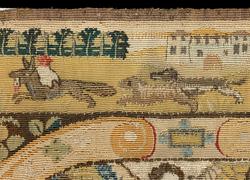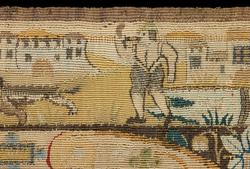Current Location: In storage
Titles
The Sacrifice of Isaac
Maker(s)
Unknown
Entities
Categories
Description
Panel for a cushion cover, woven tapestry in 'Sheldon' style, depicting the biblical story of the sacrifice of Isaac. One of a pair, the other (T.7B-1961) depicting Isaac blessing Jacob.
This tapestry depicts the sacrifice of Isaac. Isaac became the leader of his people. But when he was a child his father Abraham received a message from God telling him that he must offer his son as a sacrifice, rather than the more usual sheep or goat. The tapestry shows the moment just before Isaac’s killing: Abraham has his sword raised to strike his son when an angel appears and tells him to stop. The angel points to a ram trapped in a bush nearby and tells Abraham to kill it as an offering. Their two servants are shown watching in the background and the town from which they all came is seen beyond that.
In the horizontal borders the weaver depicts hunting scenes, including the pursuit of a fox that had stolen a goose. Each huntsman wears differently coloured clothes; some with silver threads in their breeches.
The side borders are alike in this piece and its pair (T.7B-1961) and are designed in three sections; top and bottom are two different arrangements of fruit and flowers separated by the small figure of an armed man within a semi-circular frame. Two birds perch above it.
The corners of the arch in the centre of the tapestry were decorated with different flowers, a carnation (left) and borage (right). A caterpillar crawls down the right-hand side.
Biblical source: Genesis 22:1-14
Legal notes
Bequeathed by Louis Colville Gray Clarke
Measurements and weight
Length: 52.7 cm
Width: 48.2 cm
Acquisition and important dates
Method of acquisition: Bequeathed
(1961-04-27)
by
Clarke, Louis Colville Gray
Dating
Elizabethan
1558
-
1603
Note
There is no maker’s mark on this panel. They were not thought necessary for small items. We can only guess therefore where this tapestry was made by comparing its style and appearance with other small works. The heartlands of the tapestry industry in the 1500s was in modern-day Belgium, in the towns of Brussels, Oudenarde, Enghien and later, Antwerp. The inhabitants tended towards the new Protestant religion but because the area was ruled by the Catholic king of Spain there was constant warfare. This, together with the fact that there were too many weavers for all of them to find employment against a disrupted commercial background, meant that many emigrated – north to Holland and west and north into the German principalities and beyond.
Others came to England, especially after 1560 following the accession of the Protestant Queen, Elizabeth I. The majority settled in London; others were invited by the town councils of Sandwich, Canterbury, Maidstone, Colchester and Norwich in the hope that new industries would revive the flagging local economies.
The settlement of émigrés was encouraged by the English government, aware that England lacked skilled craftsmen in the luxury trades. Some noblemen tried to set up workshops for foreign workers, usually with the obligation that they should pass on their skills to the native-born. One such man was Worcestershire nobleman, William Sheldon, who set out a scheme in his Will that would provide capital sums as loans for trained weavers, English or foreign-born, to enable them to set up independently. He also allowed a man we know as Richard Hyckes to occupy the family’s manor house at Barcheston, Warwickshire, rent-free, as long as he organised the production of tapestry and woven cloth.
How successful his plans were is unknown. Nothing is documented; there is no contract for any of the weavings now called Sheldon, nor do the workshop’s accounts survive. It was not until 1919 that a local antiquary claimed five tapestries, previously ignored, at nearby Chastleton House, as Barcheston work. Thereafter almost any tapestry without known origin or any tapestry with an English coat of arms became known as ‘Sheldon’ work, from Barcheston. But there was no solid explanation why this should be so.
Although the Fitzwilliam tapestries have been thought to be examples from Barcheston, there is no factual justification for this opinion. All the researchers of the 1920s – until recently the only studies of ‘Sheldon’ products – ignored the presence of émigré weavers in London. Barcheston was not the only place in England where tapestry was woven, as was previously thought. There is a strong possibility that the Fitzwilliam tapestries were woven in London where the émigré weavers established their workshops, and where there was a market.
This is almost certainly a panel intended for a cushion cover and would have been part of a set of six, or even twelve, from which the others are not known to survive. On both tapestries the central scene is enclosed within an arch carrying the elongated leaf and trefoil motifs worked, unusually, on a yellow ground in white and green. At least 20 differently coloured wools were used to weave this tapestry. Previously described as 'Sheldon' work, made in Barcheston, it is now thought that this cover was probably woven in London.
Warp count: 8/9 per cm, 19/20 per inch
